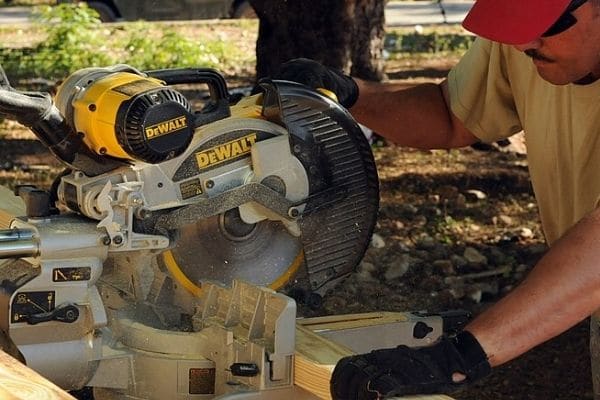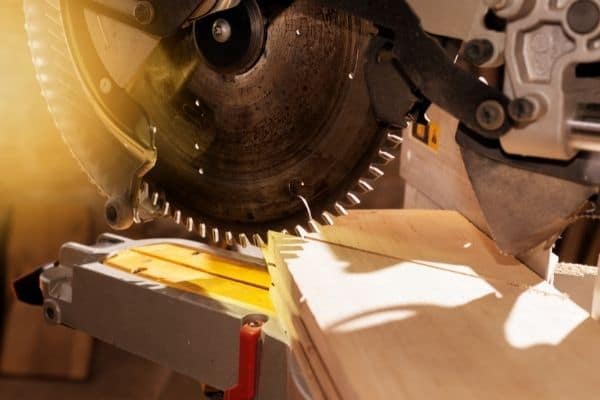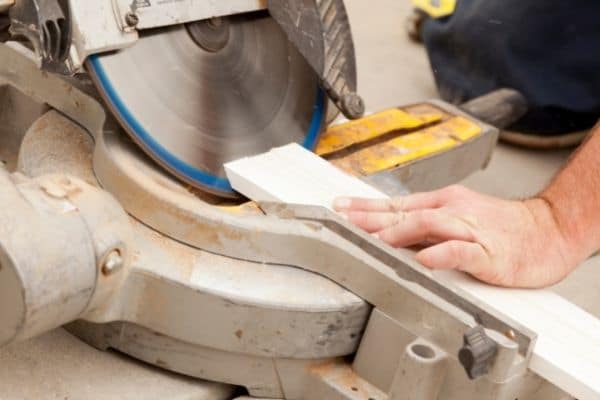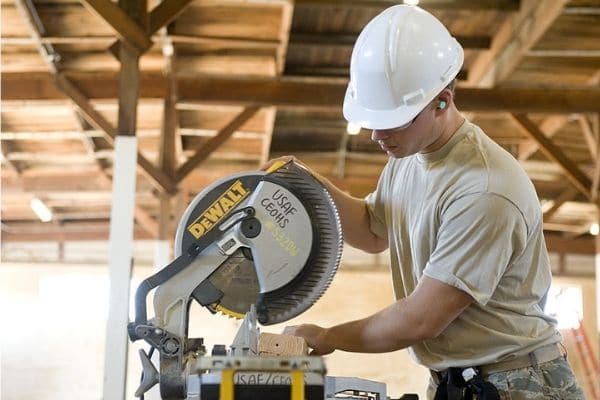
If you’re in the market for a new or replacement power saw, you’re probably wondering — what’s the difference between a single bevel vs double bevel miter saw?
Although very similar tools, making the correct decision will save you valuable downtime, increase project efficiency, and ensure you only pay for features that your most common projects demand.
Consider this article to be your double bevel miter saw vs single bevel 101 — a veritable encyclopedia of information, giving you all the trade secrets you need to make the perfect choice.
What Is a Bevel Cut?
Before we get down to contrasting a double bevel vs single bevel miter saw — it’s crucial to understand what a bevel is, and how it differs from a miter.

Miter Cut — 45 Degree Angle Addressed Perpendicular to the Wood Face
Assume you have your timber laid flat along the table plate of your miter saw. After switching the machine on and the blade is spinning at full speed, you pull down the arm head to penetrate the wood — the blade face hitting the timber at 90 degrees.
While you can reposition your target material to create angles — for example, when making 45-degree cuts to build a picture frame — the teeth always address the timber at a right angle. That, is a miter cut.

Bevel Cut — Timber Addressed At An Angle
Once again, your wood is secured on the saw plate, and the blade is spinning. You then tilt the head to an angle of your choosing and then pull down the arm to allow the blade to address the timber at an angle other than 90 degrees. That’s a bevel cut.
As it can be initially challenging to recognize the difference — even for trade pros — here’s a video demonstrating the two cut types:

What Are Bevel Cuts Used For?
There are some things that you probably cannot live without — cell phone, cold beer, laptop, and getting down and dirty in the bedroom. Your home is the same — but instead of creature comforts, it requires bevel cuts.
If you’re in your house now, take a look around — these seemingly innocuous angled shears surround you. While by no means an exhaustive list, you can see bevel cuts in:
- Baseboard joins.
- Picture rails.
- Dado rails.
- Photo frames.
- Tabletop corners.
- Cabinet joints.
- Architrave molding.
What’s more, they’re keeping your home erect — bevels are crucial for timber house frames, roof beams, struts, and rafters.
Hence, for the home-improver, woodworker, hobbyists, and DIYer — you need a miter saw capable of forming bevels. Which brings us to the focus of this article — what’s the difference between a single bevel vs double bevel?
The Double Bevel vs Single Bevel Miter Saw Difference
A single bevel miter saw such as the DeWalt DW715 has a head that tilts (or bevels) to just one side — customarily the right — to an angle typically between 0-45 degrees. A dual bevel — also known as a dual compound, twin bevel, or double compound — can angle to either the left or the right. For an excellent and versatile twin unit, check out the DeWalt DW716.
If you have a single bevel (also called a single compound) miter saw, you can still make opposite 45 degree cuts to make a join — but it means rotating and flipping the timber.
Conversely, if you own a dual bevel, you can make right or left-side angled shears without turning over the wood.
And that, my young powered saw apprentice, is how dual bevel vs single bevel miter saw units differ.
Buying Guide for Dual vs Single Bevel Miter Saw Machines
So, now you know how to differentiate single bevel vs dual bevel miter saw units, the question is — which format is most suitable for your needs?
The decision needs to be made on your personal requirements and the demands of your projects. Here’s what you need to consider:
Price
If you’re on a tight budget, single compounds are undoubtedly the more affordable solution when looking at single vs double bevel miter saw machines. If you compare like with like (blade size, engine capacity, brand, etc.), dual machines tend to be around $50-$75 dollars more expensive — due to the additional tech and components.
Size and Weight
Unsurprisingly, a dual miter saw unit is larger and weighs more than its single counterpart.
Admittedly, unless you’re a trade contractor, it’s doubtful you’re going to be moving your machine from location to location. But, it’s an important consideration for your workspace.
To ensure safe operation, miters need to be bolted or screwed to a bench or table. Hence, always ensure that your working platform has sufficient space and capacity to hold your power tool — including rear clearance. This is particularly crucial if you opt for a sliding compound format that is particularly deep.
For more info on how a slider compares to a standard miter — check out my guide here.
Time-Saving
Constantly flipping, turning, and repositioning your timber on a single bevel takes time. If you’re a casual or intermittent miter saw user completing just a few projects — this probably will not be an issue.
However, should you be a trade pro who’s working to time constraints, or a DIYer tackling large and repetitive jobs, the downtime saving aspect of a double bevel may be attractive.
Accuracy
One of the most significant differences between single vs dual bevel miter saw machines is their ease of accuracy.
While it’s possible to make opposite angle cuts with a single compound to make a perfect join — it takes a great deal of concentration. You need to put your brain into mirror mode — not only do you need to flip your timber, but also rotate it.
Trust me, this inevitably leads to mistakes.
Ok, no one is going to die. But you’re going to waste time, become frustrated, and end up putting screwed-up timber into the trash — costing you your hard-earned dollars. Using a double miter can prevent errors, allowing you to effortlessly cut from both sides without having to re-measure and reposition before every new address.
Ease of Operation
With fewer knobs, dials, and angle indexes, theoretically, a single miter is more straightforward to operate than a dual — making it more appealing to the casual novice user.
That said, if you need to make opposite direction cuts — as discussed above — their single mode of operation can complicate matters as you flip and turn the timber.
Left or Right Handed Use
Here’s something you probably didn’t expect me to say in this single bevel vs double bevel miter face-off — single machines are the same as potato peelers, scissors, tape measures, and can openers.
That is, they’re designed for right-handed operation.
Anti-leftie designers simply assume that single machine miter saw users are right-handed — making it challenging for the twelve percent of people who are the opposite way inclined.
A dual machine allows southpaws to utilize a miter machine with the same ease as a rightie. But, as this involves additional dollars for the convenience, it might work out as an expensive way just to feel included.

Dual Bevel vs Single Bevel Conclusion
You now have all the knowledge you need to decide between a single bevel vs double bevel saw!
Remember, when choosing your unit — take into account their prices, sizes and weights, the relative accuracies, and the impact on downtime. And, as an additional consideration — ponder whether you need a standard machine or a sliding compound.
I really hope you found this article educational and useful, and that it has given you all the info you require to make an informed choice — remember to check out my top picks of both single and dual machines! And, should you have a family member, colleague, or buddy who you think would benefit from this Single Bevel vs Double Bevel Miter Saw face-off — please feel free to share!
Single vs Double Bevel Miter Saw FAQs
Q: What’s the Difference Between a Single Bevel vs Dual Bevel Miter Saw?
A single bevel machine has a blade arm that can tilt to just one side. Conversely, a dual bevel arm head will lean to either side.
Q: Is a Double Bevel Miter Saw Necessary?
The double bevel — also known as the dual bevel — miter saw permits you to create both uniform and accurate cuts on either side of your working material. Making projects more straightforward and effortless without having to flip your timber — it saves time and reduces the risk of mistakes and errors.
Q: What Is More Expensive Single or Double Bevel Miter Saw?
Two-side tilting capabilities, and therefore incorporating more tech and components, dual bevel machines are typically harder on the wallet than their single bevel cousins.
Q: Is a Double Bevel Saw the Same as a Sliding Bevel Miter Saw?
A double bevel saw has a blade arm that tilts to the left and the right. A sliding miter saw incorporates the blade arm onto sliding rails — allowing you to tackle large pieces of timber.
A double bevel may, or may not, incorporate sliding rails — depending on the model.










